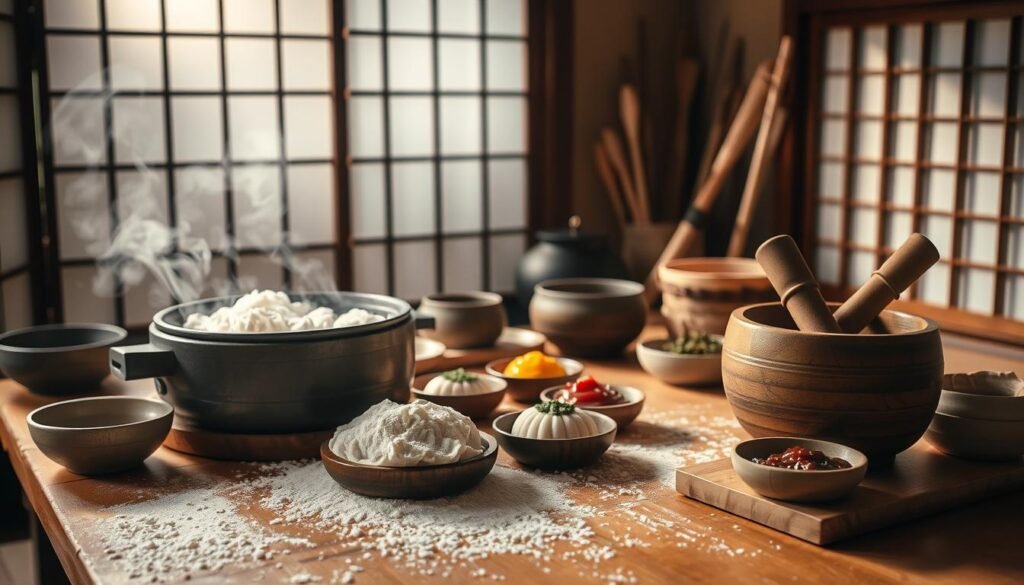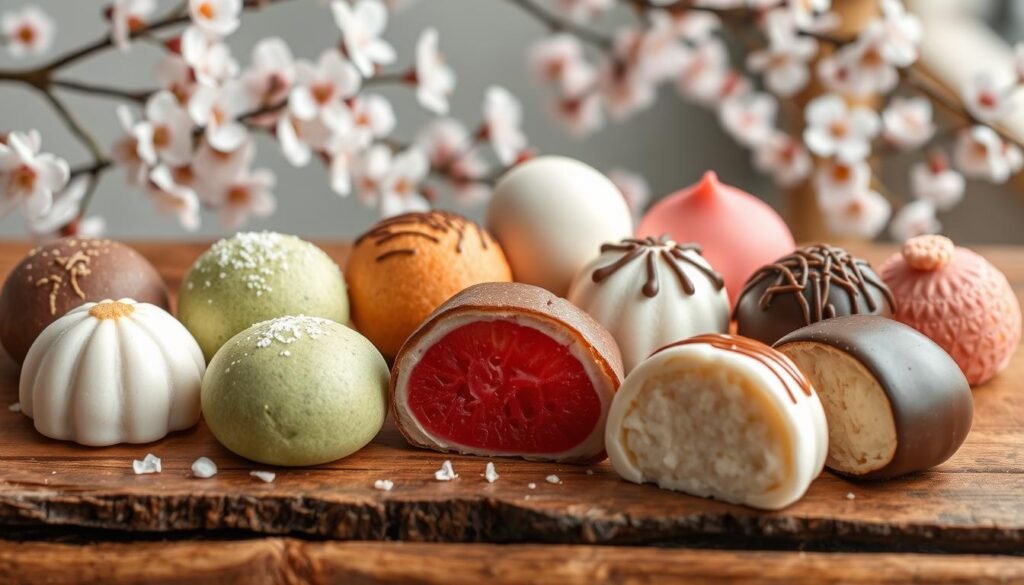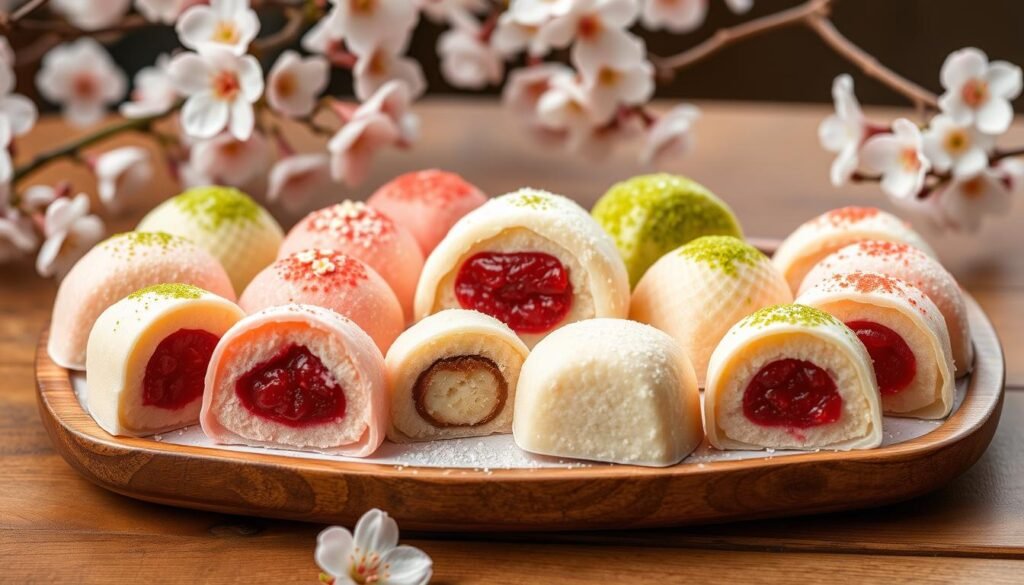I’m excited to share with you how to make authentic Japanese mochi. This dessert has been loved in Japan for centuries. You’ll learn to make delicious mochi at home with a simple recipe.
Japanese mochi is made from pounded glutinous rice. It’s often filled with sweet things like red bean paste or ice cream. To make it right, you need to know its cultural value and the right ingredients and techniques. I’ll show you how to make it, step by step, using a recipe passed down through generations.
By following this recipe, you can make mochi for special times or just for fun. If you love Japanese desserts or want to try something new, this guide is for you. Let’s start making authentic Japanese mochi together, using a recipe that’s easy and fun.
Understanding Japanese Mochi and Its Cultural Significance
Exploring Japanese mochi culture is fascinating. It has a long history and deep meaning. Mochi has been a part of Japan for centuries, starting in the Heian period.
It’s a big part of special times like New Year’s and the Cherry Blossom Festival. This shows how important it is in Japanese celebrations.
Mochi brings people together, creating a sense of community. Today, mochi comes in many flavors and fillings. But it still keeps its traditional roots.
The History of Mochi in Japanese Cuisine
Mochi’s history shows its lasting appeal. It started in ancient Japanese rituals and ceremonies.
Why Mochi Matters in Japanese Celebrations
Mochi is key in Japanese celebrations. It stands for good luck, long life, and joy. It’s a big part of Japan’s dessert culture.
Modern Day Mochi Consumption
Today, mochi is loved more than ever. It’s enjoyed on special days and as a daily treat. This shows how mochi culture is growing and important in Japan.
Essential Ingredients for Perfect Japanese Mochi
To make real Japanese mochi, you need the right stuff. The main thing is glutinous rice, also called mochigome. Use short-grain glutinous rice for the best mochi. You also need water, sugar, and salt.
Choosing the right glutinous rice is key. It makes your mochi taste and feel just right. You can find it at Asian stores or online. Make sure it says “mochigome” or “Japanese mochi ingredients” on the package.
Water, sugar, and salt are also important. They help your mochi taste and feel perfect. With these ingredients, you can make yummy Japanese mochi at home. Using top-notch glutinous rice makes your mochi special for any time.
Traditional Tools and Modern Alternatives for Mochi Making
Making mochi needs the right tools. Old tools like a big mortar and pestle are still used today. They help pound and knead the dough right.
New tools can also help. Kitchen tools like stand mixers can make mochi. Electric mochi makers make it easier and faster.
Benefits of Traditional Mochi-Making Equipment
Old tools give a real mochi-making feel. Pounding and kneading can be fun and calming.
Modern Alternatives and Kitchen Tools
New tools are quicker and easier. Electric mochi makers and stand mixers make mochi fast. They’re good for those without old tools.
| Tool | Benefits | Drawbacks |
|---|---|---|
| Traditional Mortar and Pestle | Authentic experience, meditative process | Time-consuming, physically demanding |
| Electric Mochi Maker | Convenient, efficient, consistent results | Less authentic experience, dependent on electricity |
| Stand Mixer | Convenient, efficient, versatile | May not produce same texture as traditional equipment |
Preparing Your Workspace for Mochi Making
To make delicious Japanese mochi, you need a good workspace. You’ll need a big, clean area for pounding and shaping. Also, have all your ingredients and tools ready for easy access.
A clean and organized workspace is very important. You should have a special area for getting ready. This way, you can focus on making mochi without any trouble.
Here’s a simple checklist to help you prepare your mochi making workspace:
| Tool/Ingredient | Description |
| — | — |
| Large surface | For pounding and shaping mochi |
| Ingredients | Rice, water, and any desired fillings |
| Tools | Mallet, mortar, and any other necessary equipment |
By following these steps, you can make delicious Japanese mochi easily. Always keep your workspace clean and organized for the best results.

Step-by-Step Guide to Making Japanese Mochi
To make real Japanese mochi, you need a good recipe and a clear guide. This guide will help you through each step, from starting to finish.
First, we wash and soak the glutinous rice. This is key for the mochi’s texture. Then, we steam the rice to make it sticky.
After that, we pound the rice into a sticky dough. This part takes some work but is very important. Lastly, we shape the dough into the mochi we want.
Washing and Soaking the Rice
This first step is very important. It helps make the mochi just right. By following a good recipe and guide, your mochi will be perfect.
Steaming Process
The steaming stage is also very important. It cooks the rice and makes it sticky. This is what gives the mochi its special texture.
Common Mistakes to Avoid When Making Mochi
Making mochi is a delicate task. It’s easy to make mistakes that can ruin the final product. I’ve learned that knowing common mochi making mistakes is key to getting it right.
One big mistake is pounding the dough too much or too little. This can make the mochi tough or sticky.
Another mistake is not storing it right. This can dry out or mold the mochi. Knowing how to store it properly is very important.
Texture Problems and Solutions
Texture issues are common when making mochi. To fix this, pound the dough just right. This will give you the perfect texture and avoid mistakes.
Storage Mistakes
Storing mochi wrong can also be a problem. To fix this, store it in an airtight container. Keep it in the fridge to keep it fresh and soft.
Delicious Mochi Filling Options
Mochi is great because you can fill it with many tasty things. You can use sweet red bean paste, called “an,” or ice cream. You can also try new fillings like fruit, nuts, and chocolate.
Choosing the right filling for your mochi is fun. You can pick from mochi filling options like strawberry, mango, or green tea ice cream. Mixing different fillings can make your mochi taste amazing.
Here are some popular mochi filling options:
| Filling Option | Description |
|---|---|
| Sweet Red Bean Paste | A traditional Japanese filling made from azuki beans |
| Ice Cream | A creamy and sweet filling available in many flavors |
| Fruit | A sweet and refreshing filling option, such as strawberry or mango |
There are so many mochi filling options to try. You can make your mochi special with your favorite sweet fillings. Whether you like old favorites or new ones, there’s something for everyone.
Traditional and Modern Mochi Variations
I’m excited to explore mochi’s world. There are many traditional and modern mochi types. Classic Japanese flavors like green tea and strawberry are loved for their taste and authenticity.
But, modern mochi brings new twists. Think matcha and white chocolate or sesame and honey. These unique flavors are great for those who love trying new things.

Creating your own mochi flavors is fun. You can mix seasonal ingredients with traditional ones. This way, you can find new favorites and learn about Japanese mochi’s rich culture.
Classic Japanese Flavors
Flavors like red bean paste and sweetened chestnut are mochi staples. They’re often mixed with other ingredients to make tasty mochi variations.
Contemporary Fusion Options
Modern mochi combines Japanese and international flavors. This creates exciting and innovative mochi types that will wow you.
Storing and Serving Your Homemade Mochi
To keep your homemade mochi fresh, store it in an airtight container in the fridge. This keeps the mochi soft and fresh. It’s important to prevent it from getting dry or sticky.
Serving mochi at the right temperature is key. You can serve it at room temperature or chilled. Choose based on the filling and what you like best. For sweet fillings, room temperature is good. For creamy fillings, chilled is better.
Proper Storage Techniques
Storing mochi right is crucial. Use an airtight container to keep it fresh. This stops it from picking up smells or tastes from other foods.
Serving Temperature Tips
The serving temperature affects mochi’s texture and taste. At parties, serving it at room temperature is easier to eat.
Presentation Ideas
How you present mochi can enhance the experience. Serve it on a platter or plate with fresh fruit or green tea powder. This adds color and flavor, making it a fun treat.
| Mochi Storage Tips | Description |
|---|---|
| Airtight Container | Store mochi in an airtight container to maintain freshness |
| Refrigerate | Refrigerate mochi to prevent it from becoming dry or sticky |
| Room Temperature | Serve mochi at room temperature for a softer texture |
| Chilled | Serve mochi chilled for a firmer texture |
Conclusion: Mastering the Art of Japanese Mochi Making
The journey of Japanese mochi making is exciting. It’s about tradition, patience, and being great at cooking. This article has helped me feel ready to master the art of making these tasty Japanese treats.
I can now make mochi at home. It’s fun to try new flavors and share my mochi with others. Enjoying a chewy, tasty mochi shows the beauty of Japanese cooking.
Let’s celebrate Japanese mochi making! With practice and love for this dessert, I’m sure I can master the art. Kanpai!

